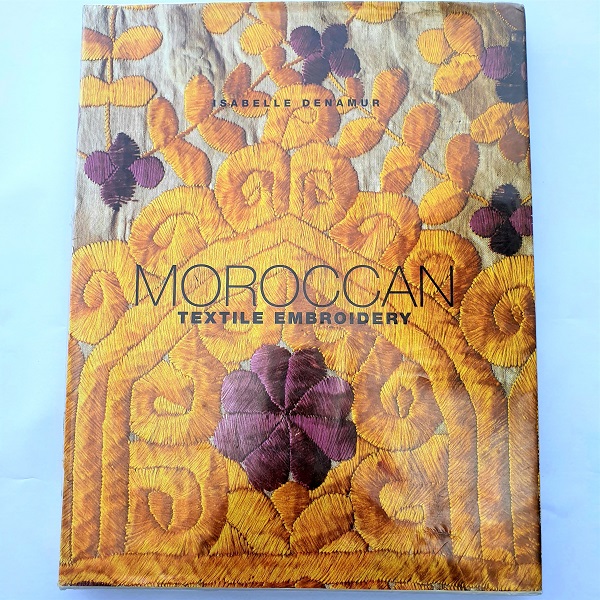Author: Isabelle Denamur
Photographer: Pierre Ferbos
Publisher: Flammarion, 2003
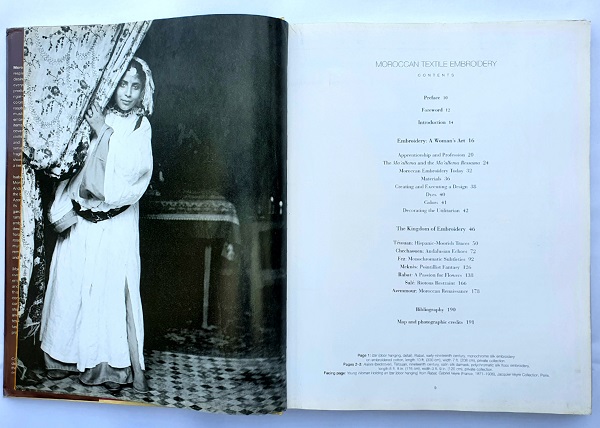
Format and layout
246 x 318 x 20 mm (9.7" x 12.5" x 0.8”)
Hardcover
192 pages
ISBN 978-20-80111-739
Text and images on a white background
English (also available in French as
Broderies Marocaines)
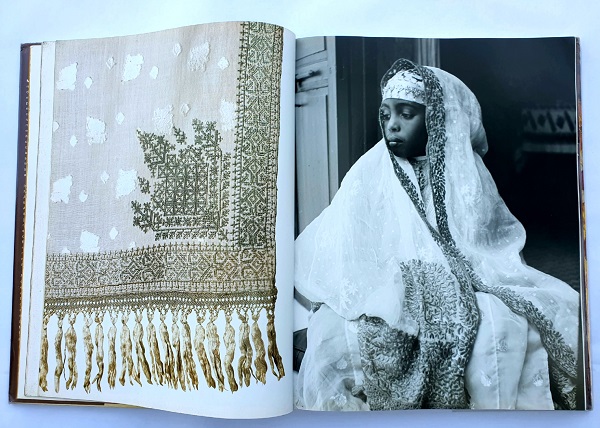
Photos, Illustrations, and Diagrams
From the vibrant gold and purple Rabat embroidery detail on the dust cover to the multiple colour plates throughout the book, the whole publication is a visual feast. Photographer, Pierre Ferbos’s detailed and close-up images of different forms of textiles, showcasing different styles of embroidery, is an essential part of the success of this book. These images are interspersed with black and white images of Moroccan people wearing these textiles, images of room interiors or other scenery showcasing these magnificent treasures.
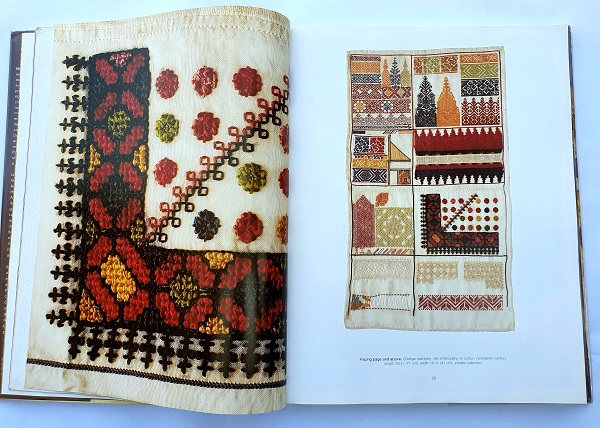
Introduction
Author, Isabelle Denamur, not only celebrates the craft of embroidery, or the ever-present role of embroidered textiles in Moroccan society, she celebrates the emotional and spiritual connection between Moroccan women and their needlework.
“The emotion I feel when looking at an antique Moroccan textile is difficult to describe. I experience the soothing pleasure induced by a thing of beauty, but also the dreamlike sense of the thread of a story. I feel the presence of another woman who is bent over her sewing frame, yet free to lose herself in her work… As a woman, I am deeply moved by the sense of escape in such pieces.” Extract from Foreword by Isabelle Denamur, p13.
This book aims to collect and summarise the main elements of Moroccan embroidery, and to encourage an understanding of this valuable heritage. Moroccan embroidery has two main influences – the impact of the Spanish-Muslim culture coming from the Andalusian Moors, as well as the Balkan – Turkish and Circassian - influences seen particularly in the embroidery work from
Fes
Fes: (synonyms: tarboush, tarbooch, tarboosh, tarbush, chachia, chechia, fez), generally red cylindrical men's felt cap with tassel. Also known as Fez after the city famous for its production in Morocco. The term is also used to denote the tassel, a bundle of suspended threads.
.
As most of these traditional methods and styles of embroidery has been replaced by modern decorations in contemporary Moroccan homes, this study of the traditional methods and styles of Moroccan embroidery leaves an important and valuable legacy.
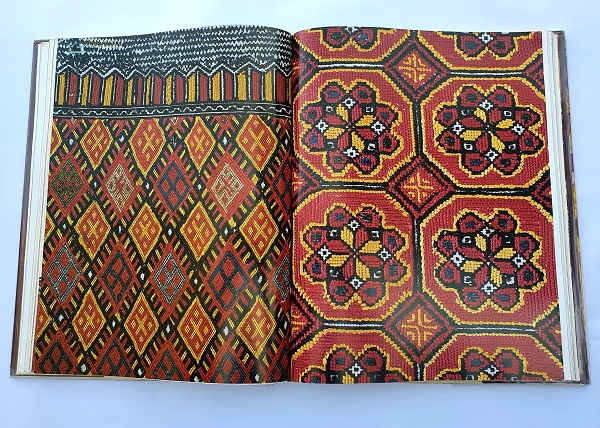
Content
The book is divided into two main sections. The first is called Embroidery: A Women’s Art and deals with the role embroidery played in society, especially in the lives of women and young girls. It looks at topics such as embroidery apprenticeships, and embroidery as a profession. It also has a short overview of the materials used, the designs and patterns, as well as the colours and dyes used for the threads. There is also a short chapter on the role of embroidery in utilitarian objects rather than as purely a decorative art form.
The second section is called The Kingdom of Embroidery and looks at the different regions and their particular style of embroidery and influences. The regions of Tetouan, Chechaouen,
Fes
Fes: (synonyms: tarboush, tarbooch, tarboosh, tarbush, chachia, chechia, fez), generally red cylindrical men's felt cap with tassel. Also known as Fez after the city famous for its production in Morocco. The term is also used to denote the tassel, a bundle of suspended threads.
, Meknes, Rabat, Salé, and Azemmour are each discussed in detail, giving a historical account as well as discussing the style and technique in detail.
The book opens with a Preface, Foreword, and Introduction and concludes with a bibliography, a map of Morocco, and credits.
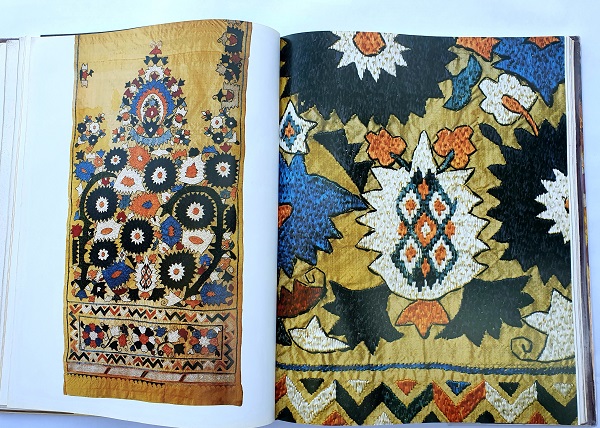
Conclusion
The author’s absolute delight with and passion for Moroccan embroidery is evident. Isabelle Denamur manages to transfer that passion to the reader. Her writing style is conversational yet informative, and Pierre Ferbos’s photography is exquisite – from the scenic images down to the close-up details of the stitching.
Moroccans use embroidery to decorate every part of their lives and homes, and many of the items described in the book are utilitarian household items and not necessarily garments or clothes. Yet, it played (and still plays) an important role in the lives of Moroccan women. Not only because they spend so much of their lives at home surrounded by these beautiful items, but also because they spent a great deal of their time, from childhood onwards, on mastering the craft of embroidery and on creating a comprehensive trousseau for their future homes.
“Down the generations, these embroiderers of a bygone age, make me feel profoundly connected to this society of women. Sometimes despite the strictly codified motifs, a careful observer can see a mistake, betrayed by just one stray stitch. These tiny errors are, to me, the most fascinating, the most human aspect of all. One might even fancy that they were made on purpose – a silent yet eloquent record of past lives and dreams.” Extract from Foreword by Isabelle Denamur, p13.

About the author
Isabelle Denamur is a French ethnologist who studied Moroccan embroidery as part of her PhD thesis on this subject. She is fascinated by Islamic art and artefacts, especially embroidery, and has travelled throughout the world in search of rare works.
She was also the curator of the exhibition
The Story of Islamic Embroidery in Nomadic and Urban Traditions, held at Gallery One at The Emirates Palace in Abu Dhabi in 2010.




